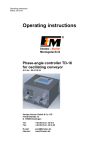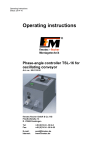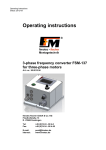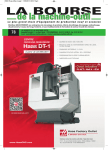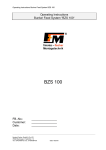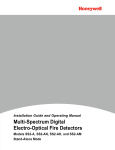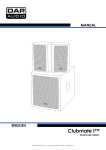Download Operating instructions - Fimotec
Transcript
Operating instructions Status: 2012-09 Operating instructions Frequency control devices FS-16 / FS-18 for oscillating conveyor Art. no.: 90.0210.50 FS-16 fimotec-fischer GmbH & Co. KG Friedhofstraße 13 D -78588 Denkingen Tel: Fax: +49 (0)74 24 - 88 4-0 +49 (0)74 24 - 88 4-50 E-mail: Internet: [email protected] www.fimotec.de Art. no.: 90.0210.52 FS-18 Operating instructions FS-16 / FS-18 The duplication, sharing or use of this documentation or its contents is only allowed with written permission. Violations result in liability for damages. All rights reserved, including such which arise from granted patents or registration of a utility patent or design. Copyright © fimotec-fischer GmbH & Co. KG 2012 Page 2 Status as of 09 / 2012 Operating instructions FS-16 / FS-18 Information and explanations Target group These operating instructions will help you to use the described product safely and as intended. They are directed toward qualified skilled personnel*. Qualified personnel are people who have been authorized by persons responsible for the safety of the system to execute the required activities and are able to recognize potential dangers and avoid them based on their training, experience and instruction, as well as their knowledge of standards, regulations, accident prevention regulations and operating conditions (definition of skilled personnel according to IEC 364). Read these operating instructions before you install the device, use it or carry out work on it. Also pass on these operating instructions to other users. Definition of the warnings and symbols Warnings are indicated by danger symbols and signal words. The table shows what hazards and possible consequences the symbols, signal words and colours indicate. Signal word ACHTUNG Definition Consequences Directly threatening danger Death or extremely serious injuries Dangerous situation Potential death or extremely serious injuries Dangerous situation Minor to moderately serious injuries Risk of property damage Damage to the machine, its environment and the product Warnings can also have other warning signs: Example: Warning of electrical current! These symbols indicate the type of hazard. Term definitions Term Definition User Persons who use the device installed by the manufacturer in its ready-touse version. Screen Designation for the image visible within the touchscreen. Button Designation for key fields on the touchscreen EMC Electromagnetic compatibility with electrical and electromagnetic influences. Skilled personnel Qualified personnel with the appropriate education, training and experience. Device Designation (in these operating instructions) for the oscillating conveyor control unit FS-16/FS-18. Machine manufacturer Persons who install the device in the intended construction (machine) and who manufacture the ready-to-use version. Menu Designation for the structural layout of the user interface. Touchscreen Touch-sensitive screen (display) with operating function. Status as of 09 / 2012 Page 3 Operating instructions FS-16 / FS-18 Table of contents 1 PRODUCT OVERVIEW ......................................................................................................................... 6 1.1 Scope of delivery .................................................................................................................................... 6 1.2 Device versions ...................................................................................................................................... 6 1.3 Available accessories, options ............................................................................................................... 6 1.4 Properties ............................................................................................................................................... 7 1.4.1 1.4.2 1.4.3 1.4.4 General ........................................................................................................................................................................................... 7 Output data ..................................................................................................................................................................................... 7 Inputs .............................................................................................................................................................................................. 7 Outputs ........................................................................................................................................................................................... 7 2 SAFETY INFORMATION ....................................................................................................................... 8 2.1 Intended use ........................................................................................................................................... 8 2.2 Basic safety information ......................................................................................................................... 8 2.2.1 Transport and storage .................................................................................................................................................................... 8 3 INSTALLATION ..................................................................................................................................... 9 3.1 Hardware installation .............................................................................................................................. 9 3.2 Mains connection ................................................................................................................................... 9 3.3 Oscillating conveyor connection ............................................................................................................. 9 3.4 Fuse protection ....................................................................................................................................... 9 4 OPERATION ........................................................................................................................................ 10 4.1 Explanation of the button and display fields ......................................................................................... 10 4.2 Description of the user levels ............................................................................................................... 11 4.2.1 Structure tree, main menu ............................................................................................................................................................ 11 Structure tree, channel menus 1, 2 and 3 ................................................................................................................................................... 12 4.2.2 Starting level ................................................................................................................................................................................. 12 4.2.3 User level, channels 1, 2, 3 .......................................................................................................................................................... 13 4.2.4 User level status 1 ........................................................................................................................................................................ 14 4.2.5 User level status 2 ........................................................................................................................................................................ 15 4.2.6 User level status 3 ........................................................................................................................................................................ 15 Menu description ............................................................................................................................................. 16 4.2.7 4.2.8 4.2.9 4.2.10 4.2.11 4.2.12 4.2.13 4.2.14 4.2.15 Main menu .................................................................................................................................................................................... 16 Sensor menu ................................................................................................................................................................................ 17 Oscillation amplitude sensor menu ............................................................................................................................................... 18 Piece counter menu ...................................................................................................................................................................... 19 Actuator menu .............................................................................................................................................................................. 20 Enable menu ................................................................................................................................................................................. 22 Password menu ............................................................................................................................................................................ 22 *1 *2 Channel menu (CHANNEL MENU 1 / CHANNEL MENU 2 / CHANNEL MENU 3 ) ................................................................. 24 Ramp menu .................................................................................................................................................................................. 25 4.3 Error display ......................................................................................................................................... 25 4.3.1 4.3.2 4.3.3 4.3.4 Overtemperature ........................................................................................................................................................................... 25 Current limit .................................................................................................................................................................................. 25 No SW sensor connected ............................................................................................................................................................. 25 Current supply interruption ........................................................................................................................................................... 25 5 DESCRIPTION OF CONTROL I/OS, FS-16 / FS-18 ........................................................................... 26 5.1 Operating status ................................................................................................................................... 26 5.2 Enable input.......................................................................................................................................... 26 5.3 Sensor input ......................................................................................................................................... 26 Page 4 Status as of 09 / 2012 Operating instructions FS-16 / FS-18 5.4 SW sensor input ................................................................................................................................... 26 5.5 Actuator output ..................................................................................................................................... 27 6 TECHNICAL DATA .............................................................................................................................. 28 7 TERMINAL ASSIGNMENTS ............................................................................................................... 29 7.1 Power connection assignments............................................................................................................ 29 8 DIMENSIONS ....................................................................................................................................... 30 9 MAINTENANCE AND CARE ............................................................................................................... 30 9.1 Regular tests ........................................................................................................................................ 30 9.2 Decommissioning and disposal ............................................................................................................ 30 10 ACCESSORIES AND OPTIONS ......................................................................................................... 31 10.1 The plug connectors listed below are available as accessories: ......................................................... 31 10.2 The connection lines and oscillation amplitude sensor listed below are available as accessories: .... 31 9 ACCESSORIES AND OPTIONS ......................................................................................................... 31 Status as of 09 / 2012 Page 5 Operating instructions FS-16 / FS-18 1 Product overview 1.1 Scope of delivery FS-16 / FS-18 control unit with software V1.0 Operating instructions 1.2 Device versions The FS-series devices are microprocessor-controlled, 1-phase frequency converters for sinusoidal actuation of consumers with variable frequency and amplitude. 1.3 Available accessories, options Oscillation amplitude sensor type: SWS-01 Page 6 Status as of 09 / 2012 Operating instructions FS-16 / FS-18 1.4 Properties 1.4.1 General Consumer output Parameterization via parameter blocks LCD touchscreen for operation Overcurrent limit for the consumer Mains input voltage monitoring Type of protection IP54 1.4.2 Frequency range 15 Hz to 320 Hz The frequency range is adjustable in steps of 0.1 Hz for all variants. Power adjustable from 0% to 100% in steps of 1%. Soft start ramp / soft stop ramp adjustable from 0 to 10 seconds Switch-on and -off delay in range from 0 to 60 seconds 1.4.3 Inputs Enable input for switching on/off without power Sensor input with switch on/off delay in range from 0 to 60 seconds SW sensor input 1.4.4 Output data Outputs Operating notification relay contact 230 VAC / 6A (changeover contact). Consumer output for oscillating conveyor Actuator output +24 V DC Actuator output 230 V AC / 3 A only on FS-18 Status as of 09 / 2012 Page 7 Operating instructions FS-16 / FS-18 2 Safety information 2.1 Intended use The FS-series devices are pieces of electrical equipment and are intended for use in supply mechanisms or automation systems. The devices are designed for the regulation and control of oscillating conveyor systems. The electrical components listed here are called "devices" in the industrial parlance, but are not devices which can be used or connected or machines in the sense of the "Device safety law", the "EMC law" or the "EC Machinery Directive", but components. Only when these components are integrated in the construction of the machine manufacturer is the ultimate mode of operation defined. The machine manufacturer is responsible for making sure that the construction meets the existing legal regulations. 2.2 Basic safety information The following warnings both serve for the personal safety of the user as well as the safety of the described products and the devices connected to them. Non-observance can lead to death, serious bodily injury or property damage. DANGER Life-threatening danger due to electric shock! Even after the device is put out of operation by disconnecting the voltage, there is still dangerous electrical voltage on the internal circuit parts. Disconnect the device from the supply voltage before any intervention. Before opening the device, wait for at least 5 minutes until the residual voltage has dissipated. Check to make sure there is no voltage before any intervention. Only skilled electricians may work on electrical equipment. Before commissioning, make sure that the voltage supply agrees with the nominal values of the device. Check the electrical equipment of the machine regularly. Deficiencies, such as loose connections, damaged or scorched lines, must be fixed immediately. Observe the valid accident prevention and safety regulations for your application. In particular, observe both the general and the regional installation and safety regulations for working with dangerous voltages (e.g. EN 50178) as well as the regulations having to do with the proper use of tools and the use of personal safety equipment. The Emergency Stop mechanisms must remain in effect in all operating modes. Unlocking the Emergency Stop mechanisms must not result in uncontrolled reactivation. 2.2.1 Transport and storage Problem-free and safe operation of this device require proper transport, storage, setup and installation, as well as careful operation and maintenance. The device must be protected against mechanical impacts and vibrations during transport and storage. Protection against moisture, water and impermissible temperatures (see chapter 6 Technical data) must also be guaranteed. Page 8 Status as of 09 / 2012 Operating instructions FS-16 / FS-18 3 Installation ATTENTION 3.1 If the device is not correctly connected, this can lead to the failure or complete destruction of the device (and the connected load). Hardware installation The FS-16 and FS-18 devices are designed for external installation (outside of a control cabinet) and have IP54 protection. If the device is mounted on a mounting plate made of metal, it can be installed with its entire area in contact with the plate or with spacers. If the device is mounted to a thermally non-conductive surface, it is to be mounted at a distance of at least 10 mm from its surface. 3.2 Mains connection The mains must be connected according to the valid regulations. It is connected via the attached Schuko "power" plug. All touchable, electrically conductive housing parts must be grounded according to the valid regulations. The connection must be made with at least a 1.0 mm² line cross-section. 3.3 Oscillating conveyor connection This is connected via the "X11" socket. The pin assignments are as follows: Pin 1 Connection for load Pin 2 Connection for load PE Connection for the ground protection conductor The oscillating conveyors are connected to these connections. 3.4 Fuse protection The fuse protection on the primary side depends on the line cross-section. However, it must be designed to have a B6 line protection switch at minimum. The devices are also protected with internal fuses. Caution!: Leakage currents against PE might occur due to EMC-related suppressor components. These are harmless, however, when an industry-standard RCD switch is used with a tripping current of 0.3 A. Status as of 09 / 2012 Page 9 Operating instructions FS-16 / FS-18 4 Operation The device is operated via a touchscreen. The corresponding function is executed by touching the respective field on the touchscreen with a finger or blunt object. 4.1 Explanation of the button and display fields Status display field Button as switch Button as push-button Figure 1: Screen description Field Definition Status display field In the status display field, the menu names and error messages are shown. Button The term "button" designates the display field on the touchscreen, via which the displayed function is controlled. Function: Button as switch: If the button is not actuated as a switch, this is shown with a blue background (see "ON" button in Figure 1). If the button is actuated as a switch, this is shown with a white background (see "OFF" button in Figure 1). The button (as a switch) works with positive button pressure. That means that when the button is pushed by pressing on the touchscreen, the respective function is executed immediately. Function: Button as push-button: If the button is not actuated as a push-button, this is shown with a blue background (see "INFO" and "MENU" buttons, Figure 1). If the button is actuated as a push-button, this is shown as being "pressed" (shifted back) (see "" button Figure 1). The button (as a push-button) works with negative button pressure. This means that when the button is pressed, the respective function is only executed when the button is released again. Display field with status display Figure 2 Display field with status display Field Definition Display field with status display: In this display field, the current status of the respective parameter is visualized. If the status is "inactive", the contents are shown with a blue background. If the status is "active", the contents are shown with a white background. Page 10 Status as of 09 / 2012 Operating instructions FS-16 / FS-18 4.2 Description of the user levels In this chapter, the different user levels will be shown and described. 4.2.1 Structure tree, main menu Status Menu Delay On Parameter Sensor X Delay Off Delay Off Connect Connect SW sensor Delay On Actuator 1 Delay Off Actuator 2 Status Sync mode Set L1 L2 L3 No. of conveyor CH1 conveyor Enable, internal Password CH2 conveyor CH3 conveyor Default Status as of 09 / 2012 Page 11 Operating instructions FS-16 / FS-18 Structure tree, channel menus 1, 2 and 3 Menu Menu Menu Soft start Soft stop Set ramp Power input Power 2 Max power Current limit 4.2.2 Starting level On the starting level, the user can switch the FS-16/FS-18 on and off. The structure of this screen is described in Table 1. Screen display Description Status bar: The status bar shows the status of the FS-16/FS-18. Display: Ready for operation Status bar: The stars represent external input signals. External enable Sensor 1 *1 Sensor 2 *2 Sensor 3 External parameter line Bit0 External parameter line Bit1 External parameter line Bit2 External parameter line SET ON/ OFF button: The power outputs are activated via the ON button. The power outputs are deactivated via the OFF button. Display: ON button not actuated, OFF button actuated INFO button: MENU button: button: Branching to the FS-16/FS-18 information screen. Branching to the main menu. Branching to the user levels. Table 1: Starting level Page 12 Status as of 09 / 2012 Operating instructions FS-16 / FS-18 4.2.3 User level, channels 1, 2, 3 The user levels channel 1, channel 2 and channel 3 are identically structured. In the following Table 2, the structure is described based on the user level channel 1. Screen display Description Display field: Shows the name of the user level. ACTIVE button: Button for activating the channel. Display: channel is not active ACTIVE button: Button for activating the channel. Display: channel is active POWER button: Is branched to the screen for specifying the capacity. FREQUENCY button: Is branched to the screen for specifying the nominal frequency. Display fields: 0-100 %: 15-320 Hz: 15-320 Hz: 20-320 Hz: Display of the current capacity after enable signal. Display of the current nominal frequency Variant Solo/Duo channels 1 and 2 Variant Trio channel 1 Channels 2 and 3 button: MENU button: button: Branching to the previous level. Branching to the channel menu. Branching to the next level. Table 2: Display of user levels channels 1, 2 and 3 4.2.3.1 Capacity, nominal value specification In this menu, the capacity can be set via the touchscreen. Screen display Description Set the capacity: On the main screen, press the button. Press once to change channel 1. Press twice to change channel 2. Press three times to change channel 3. Now the screen shown on the left appears for channel 1, 2 or 3. Call up screen for the power: Press the POWER button. To increase power: Press or hold the button. To reduce power: Press or hold the button. Attention: If the maximum capacity "POWER MAX" is limited in the channel menu, this limit is the maximum for 100%. Then the following function applies: Capacity 0 - <=(POWER MAX) value. Once input has been made, the value is saved by pressing the SET button and the window is closed. Table 3: Capacity nominal value specification menu Status as of 09 / 2012 Page 13 Operating instructions FS-16 / FS-18 4.2.3.2 Nominal frequency specification In this menu, the nominal frequency can be set via the touchscreen. Screen display Description Set nominal frequency: On the main screen, press the button. Press once to change channel 1. Press twice to change channel 2. Press three times to change channel 3. Now the screen shown on the left appears for channel 1. Call up screen for the frequency: Press the FREQUENCY button. Frequency increase: Press or hold the button. Frequency reduction: Press or hold the button. Specification of the nominal frequency from 15/20 – 320 Hz; Resolution: Steps of 0.1 Hz. Save nominal value: Pressing the SET button saves it. The window will close. Table 4: Nominal frequency specification menu 4.2.4 User level status 1 The "Status 1" screen shows the channel properties. The parameters are described in Table 5. Screen display Description Display field: Shows the name of the user level. CH1: Status display for channel 1 ACT: RUN: INT/EXT Channel 1 activated/not activated. RUN active/ RUN inactive. Capacity specification INTERNAL/EXTERNAL. Link with actuator output. A1/A2: Display: channel activated Display: output not active Display: internal Display: CH1 linked with actuators 1 and 2. Table 5: Display status 1 Page 14 Status as of 09 / 2012 Operating instructions FS-16 / FS-18 4.2.5 User level status 2 The "Status 2" screen shows the sensor links and settings. The structure of the "Status 2" screen is described in Table 6. Screen display Description Display field: Shows the name of the user level. Sensor status display S1: *1 *2 Display: S1-> Sensor1 Sensor not active Display: Sensor 1 linked with channel 1 and actuator 1. CH1,CH2 , CH3 , *1 *2 S1, S2 , S3 , A1, *2 A2 Shows the link with sensor 1. OFF, N.O., N.C. Sensor setting status Display: Sensor 1 OFF (switched off) P2 D Second nominal value spec. Time delay Display: Power 2 active Display: Time delay active button Branching to next sensor status SWS Sensor status display OFF, CH1, CH2, CH3 Indicates the assignment for the oscillation amplitude sensor Display for control range overshoot. MIN, MAX button: Exit button: *1,*2 Display: SWS Sensor not active Display: Assignment channel 1 Display: Control range at maximum Branching to the previous level. Branching to start screen. Table 6: Display status 2 4.2.6 User level status 3 The "Status 3" screen shows the operating hours counter and the piece counter. The structure of the "Status 3" screen is described in Table 7. Screen display Description Display field: Shows the name of the user level. FS-16: Indicates the operating hours during which the device was switched on. CH1: Indicates the operating hours during which channel 1 was active. button Branching to next level QUANTITY Indicates the total piece number that the sensor counted. Reset only possible in the main menu. QUANTITY Piece counter with reset function. button: Exit button: Branching to the previous level. Branching to start screen. Table 7 Status 3 display Status as of 09 / 2012 Page 15 Operating instructions FS-16 / FS-18 Menu description 4.2.7 Main menu Screen display Button MENU Screen display Call up the main menu: Press the MENU button. The FS-16/FS-18 has eight parameter blocks (0-7) in which different settings are stored and can be called up again. Parameter (PARAMETER) Sensor 1 (SENSOR 1) For branching to sensor menu, see section 4.2.8. Oscillation amplitude sensor (SW SENSOR) For branching to sensor menu, see section 4.2.9. Piece counter (PIECE COUNTER) For branching to the piece counter menu, see section 4.2.10 Actuator 1 (ACTUATOR 1) Enable (ENABLE) Password (PASSWORD) For branching to actuator menu, see section 4.2.11. For branching to enable menu, see section 4.2.12. For branching to password menu, see section 4.2.13. Factory settings (DEFAULT) Query whether the current settings should really be reset to the factory settings. Table 8: Main menu 4.2.7.1 FS-16/ FS-18 (SW Sensor / Actuator 1) A socket is available for the actuator and SW sensor of FS-16/FS-18. The socket function can be defined via the main menu. Screen display Button Screen display SW SENSOR ACTUATOR 1 Table 9: SW Sensor / Actuator 1 Page 16 Status as of 09 / 2012 Operating instructions FS-16 / FS-18 4.2.8 Sensor menu The following Table 10 shows the structure. Screen display Button MENU SENSOR 1 Status (STATUS) Screen display Press the MENU button. Press button , until the desired sensor appears. Select the desired sensor Sensor input not active Sensor input active Switching status N.O. "normally open", active when contact closed Sensor input active Switching status N.C. "normally closed", active when contact open On delay (DELAY ON) On delay setting (setting range 0.0 s – 60.0 s) Off delay (DELAY OFF) Off delay setting (setting range 0.0 s – 60.0 s) Sensor is active (SENSOR ON) When the sensor is active, the power of the defined channel 1, channel 2 or channels 1&2 are reduced to zero. When the sensor is active, the power from the defined channel 1, channel 2 or channels 1&2 are adapted to the specified setpoint 2. Link (CONNECT) Sensor X has a link. Sensor X is linked with channel 1. Table 10: Sensor menu Status as of 09 / 2012 Page 17 Operating instructions FS-16 / FS-18 4.2.9 Oscillation amplitude sensor menu The following Table 11 shows the structure. Screen display Button MENU SW SENSOR*2 Screen display Press the MENU button. Press the button until "SW SENSOR" appears. Press button, select SW sensor. SW sensor not active. SW sensor linked to channel 1 Table 11: Oscillation amplitude sensor menu 4.2.9.1 Oscillation amplitude sensor function For this procedure, it is assumed that the parameters for the oscillating conveyor are correctly set. Procedure: 1. 2. 3. 4. 5. Switch off FS-16/FS-18 power output with the OFF button. Connect the oscillation amplitude sensor from the company FFM (article designation SWS-01) to the FS-16/FS18. In the oscillation amplitude sensor menu, select the corresponding channel 1. Switch on the FS-16/FS-18 power output with the ON button. On the user level of the selected channel, set the nominal capacity and confirm with the "SET" button. The SW sensor now regulates to the specified nominal capacity. If this is to be changed, the procedure should be executed again starting with step 5. When the control range is exceeded, this is displayed under "Status 2" of the SW sensor. ATTENTION Page 18 In software version 1.0, only possible via internal setpoint specification. Status as of 09 / 2012 Operating instructions FS-16 / FS-18 4.2.10 Piece counter menu The following Table 12 shows the structure. Screen display Button MENU PIECE COUNTER Status (STATUS) Screen display Press the MENU button. Press the button until "PIECE COUNTER" appears. Switch off piece counter Switch on piece counter Reset (TOTAL RESET) All piece counters are reset. Table 12 Piece counter menu Status as of 09 / 2012 Page 19 Operating instructions FS-16 / FS-18 4.2.11 Actuator menu The following Table 13 shows the structure. Screen display Button MENU ACTUATOR 1 Link (CONNECT) Screen display Press the MENU button. Press button until "ACTUATOR 1" appears. Select the desired actuator Off delay setting (setting range 0.0 s – 60.0 s) Link actuator output X to sensor 1. Actuator output becomes active/inactive when set delay times of sensor 1 have elapsed. Link actuator output to channel 1. Actuator output becomes active when channel 1 is active and inactive when channel 1 is switched off. Time delay (DELAY ON) Actuator output switch-on delay. Actuator output becomes active after 2 s when channel X is switched on. Actuator output switch-on delay. Actuator output is active for 2 s before channel X is switched on. Time delay (DELAY OFF) Actuator output switch-off delay. Actuator output is active for 2 more seconds after switching off channel X. Actuator output switch-off delay. Actuator output switches off 2 seconds before channel X is switched off. Table 13: Actuator menu Page 20 Status as of 09 / 2012 Operating instructions FS-16 / FS-18 The time delays for the actuator outputs can only be used if there is a link to an output channel (CHANNEL X). The following diagrams show the various switch-on/switch-off delays for the actuator outputs. Setting: Delay On > 0 s Delay On Channel X Actuator output X Time Setting: Delay On < 0 s Delay On Channel X Actuator X Time Setting: Delay Off > 0 s Delay Off Channel X Actuator X Time Setting: Delay Off < 0 s Delay Off Channel X Actuator X Time If both actuator outputs are linked to the same channel X, the delay times are executed as follows. Setting: Actuator 1: -2.0 s Delay On Delay Off -2.0 s 3.0 s Actuator 2: Delay On Delay Off -4.0 s 5.0 s 5.0 s -4.0 s 3.0 s Enable Channel X Actuator 1 Actuator 2 Time Status as of 09 / 2012 Page 21 Operating instructions FS-16 / FS-18 4.2.12 Enable menu The following Table 13 shows the structure. Screen display Button MENU Enable (ENABLE) Screen display Press the MENU button. Press button until "ENABLE" appears. Activate internal enable. Internal enable (ENABLE INTERN) Deactivate internal enable. Deactivate external enable External enable (ENABLE EXTERN) External enable, switching status N.O. "normally open", active when contact closed External enable, switching status N.C. "normally closed", active when contact open Table 14: Enable menu 4.2.13 Password menu The following Table 15 shows the structure. Screen display Button MENU PASSWORD1 Password not active (PASSWORD OFF) Low password protection (LOW PROTECTION) Page 22 Screen display Press the MENU button. Press the button until "PASSWORD" appears. If the FS-16/FS-18 has password protection, this must be entered to deactivate. LOW PROTECTION: 7951 HIGH PROTECTION: 6842 LOW PROTECTION protects all input parameters, such as power, etc. The ON/OFF function is not protected with this type of protection. Password for LOW PROTECTION: Status as of 09 / 2012 Operating instructions FS-16 / FS-18 Screen display Button Screen display 7951 High password protection (HIGH PROTECTION) STATUS: LOGGED HIGH PROTECTION - all inputs to the device are protected. Password for HIGH PROTECTION 6842 This is displayed when the password has been correctly input. As long as one is logged in, there will be no password query. Table 15: Password menu Note regarding password protection Password protection active: Status as of 09 / 2012 Before changing input parameters, the password must be entered according to the type of protection. A correctly entered password is active for two minutes after the last press of a button. Page 23 Operating instructions FS-16 / FS-18 4.2.14 Channel menu (CHANNEL MENU 1 / CHANNEL MENU 2*1 / CHANNEL MENU 3*2) The channel menus for power output 1 (CH1), power output 2 (CH2)*1, power output 3 (CH3)*2 have the same structure. The following Table 16 shows the structure. Screen display Button MENU Set ramp (SET RAMP) Type of setpoint specification for the capacity (POWER INPUT) Screen display Press the MENU button. For branching to the ramp menu, see section 4.2.15 The capacity setpoint is specified via the touchscreen. The capacity setpoint is specified via the analog input. Specification 0-10 V corresponds to 0-100%. The capacity setpoint is specified via the analog input. Specification 4-20 mA corresponds to 0-100%. Setpoint specification, power 2 (POWER 2) Output limit (POWER MAX) Current limit (CURRENT LIMIT) Setting the setpoint specification for capacity 2. (setting range 0-100%). Setting the maximum capacity. (setting range 0-100%). Setting for the maximum current on channel 1 (setting range 1.0-6.0 A). Setting for the maximum current on channel 2 *1 (setting range 1.0-3.0 A). Setting for the maximum current on channel 2 *2 (setting range 1.0-3.0 A). Table 16: Channel menu Page 24 Status as of 09 / 2012 Operating instructions FS-16 / FS-18 4.2.15 Ramp menu Screen display Button Screen display Soft start ramp (SOFT START) Soft start ramp setting. (setting range 0.1 s – 10.0 s). Soft stop ramp (SOFT STOP) Soft stop ramp setting. (setting range 0.1 s – 10.0 s). Table 17: Ramp menu 4.3 Error display Description of the errors shown on the screen. 4.3.1 Overtemperature Screen display Screen description When the maximum permissible temperature of the FS-18/FS-16 is exceeded, this is displayed on the screen. In the status bar, "ERR: OVERHEAT" will appear. In addition, the current temperature is schematically displayed via a white bar. Once the temperature is in the normal range (white bar gone), the previous operation is continued. Table 18: Overtemperature error 4.3.2 Current limit Screen display Screen description If the current is exceeded at the channel output, the respective display appears in the status bar: "ERR: CURRENT LIMIT 1". Channel output 1 is at the current limit. *1 "ERR: CURRENT LIMIT 2". Channel output 2 is at the current limit. *2 "ERR: CURRENT LIMIT 3". Channel output 3 is at the current limit. *1 "ERR: CURRENT LIMIT 1&2". Channel outputs 1 and 2 are at the current limit *2 "ERR: CURRENT LIMIT 1&3". Channel outputs 1 and 3 are at the current limit *2 "ERR: CURRENT LIMIT 2&3". Channel outputs 2 and 3 are at the current limit *2 "ERR: CURRENT LIMIT 1&2&3". Channel outputs 1, 2 and 3 are at the current limit Table 19: Current limit error 4.3.3 No SW sensor connected Screen display Screen description "ERR: NO SW SENSOR" is displayed when no SW sensor is detected at the input. Cause of error: No sensor connected. Cable breakage. Defective sensor. Table 20: SW sensor error 4.3.4 Current supply interruption Screen display Screen description This screen appears if the current supply to the FS-16/FS-18 is interrupted (e.g. due to a power failure or switching off the power supply). The FS-16/FS-18 switches off the power output *1 *2 (Channel 1) (Channel 2 ) and (Channel 2 ) in this state. The last operating state is saved and is continued when the voltage supply is switched on. Table 21: Current supply interruption error Status as of 09 / 2012 Page 25 Operating instructions FS-16 / FS-18 5 5.1 Description of control I/Os, FS-16 / FS-18 Plug connection X21 Designation Enable X22 Sensor X23 Operation status output X24 Actuator / SWS X12 Actuator 230 V AC "FS-18 only" 1: +24 V DC 2: Signal 1: +24 V DC 2: 0 V 4: Signal 1: N.O. 2: Changer 3: N.C. 1: +24 V DC 2: Actuator output 3: 0 V 4: SW sensor 1: 230 V AC 2: 0 V Operating status The operating output is designed as a potential-free changeover contact with a maximum loadability of 230 V AC / 6 A. 5.2 Enable input The enable input is for switching the oscillating conveyor connected to the FS-16 /FS-18 on and off without power. The enable must be designed via a potential-free contact. (e.g.: external switch) 5.3 Sensor input The load output of the FS-16 / FS-18 can be switched on/off via a sensor, e.g. filling level sensor. Via the global menu, the on and off delay times can be set within a range between 0 – 60 sec. The resolution is 0.1 seconds. In the following Figure 3, the time curve is shown graphically. Figure 3: Time curve for load output, sensor input 5.4 SW sensor input The oscillation amplitude sensor input of the FS-16 / FS-18 is also connected to input X24. For the function, see section 4.2.9 Main menu, SW SENSOR. Page 26 Status as of 09 / 2012 Operating instructions FS-16 / FS-18 5.5 Actuator output The actuator output of the FS-16 / FS-18 is a digital output, which is freely selectable. See section 4.2.7 Main menu ACTUATOR. The output has a voltage of +24 V and a load current of max. 700 mA. The output is short-circuit proof. A constant overload should be avoided, however. 0V means that the actuator output is switched off. +24 V means that the actuator output is switched on. The FS-18 has a separate actuator output with 230 V AC / 3 A. Status as of 09 / 2012 Page 27 Operating instructions FS-16 / FS-18 6 Technical data Supply voltage: 230 V AC / 115 V AC (other voltages possible after consultation) Supply voltage tolerance: ± 10 % Mains frequency: 50/60 Hz (other frequencies possible after consultation) Output current (CH1) FS-16 6A Output current (CH1) FS-18 8A Output voltage: 0 … 210 V Enable Contact 24 V DC Load current, sensor 1: 24 V DC each, max. 100 mA Load current, actuator 24 V DC each, max. 700 mA (FS-18 230 V AC, max. 3 A) Status output, potential-free changeover contact Changeover contact, 230 V AC / 6 A Operation: Touchscreen Display: LCD display, 128x64 pixels Type of protection: IP54 Permissible ambient temperature 5°C to 45°C Permissible relative humidity max.95 %, non-condensing. Dimensions: approx. (h)185 mm x (w)109 mm x (d)115 mm EMC Interference emissions and noise immunity in acc. with EN 61000-6-x Noise immunity in acc. with EN 61000-4-x Electrostatic discharge strength (ESD) IEC / EN 61000-4-2 HF irradiation IEC / EN 61000-4-3 ("Burst") IEC / EN 61000-4-4 ("Surge") IEC / EN 61000-4-5 HF current infeed IEC / EN 61000-4-6 Voltage drop, voltage interruption IEC / EN 61000-4-11 Page 28 Status as of 09 / 2012 Operating instructions FS-16 / FS-18 7 Terminal assignments ATTENTION 7.1 If the device is not correctly connected, this can lead to the failure or complete destruction of the device (and the connected load). Power connection assignments Status as of 09 / 2012 Plug connection Power Designation Supply voltage X10 Mains output X11 Consumer output F1 Fuse 115 V AC…230 V AC 50 Hz / 60 Hz 1: 230 V AC 2: 0 V PE: PE 1: Load 2: Load PE: Protective ground conductor 6.3 A, slow-blow Page 29 Operating instructions FS-16 / FS-18 8 Dimensions 9 Maintenance and care 9.1 Regular tests The devices are usually maintenance-free. The electrical equipment of the machines are still to be checked regularly by skilled electricians. If it's dirty, clean the touchscreen with a conventional window cleaner and a soft, lint-free cloth. 9.2 Decommissioning and disposal The device is to be decommissioned by skilled electrical personnel while complying with the valid safety regulations. The packaging of the converter can be recycled. Please keep the packaging for later use. Easily removable screw connections allow the device to be disassembled into its components. These individual components can be recycled. Please carry out disposal in agreement with the local regulations. Problematic materials must not be thrown away in the normal waste! Dispose of problematic materials properly, safely and in an environmentally-friendly manner. Page 30 Status as of 09 / 2012 Operating instructions FS-16 / FS-18 10 Accessories and options 10.1 The plug connectors listed below are available as accessories: Function Mains output connection Enable/disable connection Filling level sensor connection Operating status output connection Actuator connection, 230 V (FS-18 only) Slot X10 X21 X22 X23 X12 Article number 91.3300.20 91.3300.70 91.3300.40 91.3200.60 91.3300.30 10.2 The connection lines and oscillation amplitude sensor listed below are available as accessories: Function Vibration conveyor connection Vibration conveyor connection Vibration conveyor connection Connection of a filling level sensor Connection of a filling level sensor Connection of a filling level sensor Connection of a filling level sensor Connection of a level sensor Connection of a level sensor Disable connection to a TSM-11 control Disable connection to a FSM-137 control or FS-16 / FS-18 / TD-16 control unit Disable connection to a FSM-137 control or FS-16 / FS-18 / TD-16 control unit Disable connection to a FSM-137 control or FS-16 / FS-18 / TD-16 control unit Connection of an oscillation amplitude sensor, SWS-01 Connection of a sorting air valve 24 V Y piece for connecting an oscillation amplitude sensor in combination with sorting air, 24 V Connection Sorting air valve 230 V FS-18 only Connection Sorting air valve 230 V FS-18 only Status as of 09 / 2012 Length, line 1.5 m 3m 5m 3 m, straight plug 5 m, straight plug 3 m, angled plug 5 m, angled plug 3 m, angled plug 5 m, angled plug 3m Slot X11 X11 X11 X22 X22 X22 X22 X22 X22 X23 Article number 91.4301.20 91.4301.00 91.4301.10 91.4210.01 91.4210.02 91.4210.03 91.4210.04 91.4201.03 91.4201.04 91.4280.01 3m X23 91.4280.02 5m X23 91.4280.03 0.3 m X23 91.4280.04 X24 90.1130.03 X24 91.4220.03 X24 91.3900.02 3 m, Festo MSUDK CB5K X 91.4220.01 3m Festo MSUDK IB5K X 91.4220.02 3 m, angled socket Page 31































